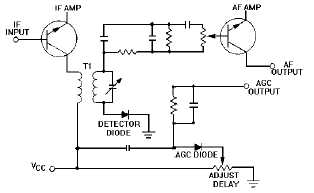7
1-58. Changes in receiver input strength due to
changing atmospheric conditions is
described by which of the following
terms?
1. Gain
2. Fading
3. Ducting
4. Trapping
1-59. The rf amplifier connected to your
receiving antenna has a voltage gain of
240. When the antenna is receiving a
signal of 8 microvolts, what will be the
maximum output voltage of the rf
amplifier?
1. 1.92 millivolts
2. 2.91 microvolts
3. 30 microvolts
4. 33 millivolts
Figure 1A.
IN ANSWERING QUESTIONS 1-60 AND
1-61, REFER TO FIGURE 1A.
1-60. If the agc diode shorts, which of the
following actions would result?
1. There would be no aqc
2. There would be no delay
3. The agc diode would be reverse
biased
4. The polarity of the agc would be
reversed
1-61. The amount of agc feedback depends on
attaining an established received signal
strength. If the established signal
strength is set for 50 microvolts, and the
input signal measures 44 microvolts,
approximately which, if any, of the
following values of agc is developed?
1. 44 microvolts
2. 50 microvolts
3. 94 microvolts
4. None of the above
1-62. To automatically compensate for input
signal strength variations within a
receiver, which of the following types of
circuits are added?
1. Afc
2. Nfc
3. Agc
4. Nsu
1-63. AgC circuitry within a receiver uses a
portion of which of the following
detector voltage components as a
feedback signal to preceding stages?
1. Dc
2. Ac
3. IF
4. Audio
1-64. Which of the following types of agc
voltage drives an amplifier toward
cutoff?
1. Saturation
2. Delayed
3. Reverse
4. Forward


